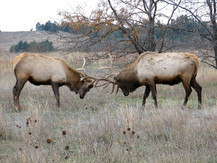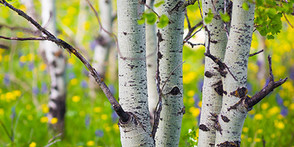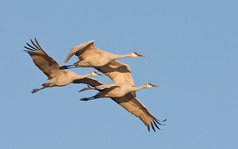Sprigs of scientific discoveries for natural resources managers
|
|
|
Volume 10 - November 2022
Wildlife Habitat Management
Greetings and happy fall! As we humans brace ourselves for the coming of winter, many of the state's wildlife species have already begun their yearly rituals of migration and hibernation. But preparing for the cold, a challenge our native species face on an annual basis, is small-scale compared to some of the habitat threats highlighted in this edition's set of articles: emerald ash borer, climate change and land conversion, to name a few. As the studies below point out, there are many challenges and trade-offs involved when managing for multiple objectives alongside wildlife habitat goals. Each of the articles offers tools and perspectives on strategies for achieving the best possible outcome. Two of the articles provide case studies that focus on sandhill cranes, one wildlife success story among many in Minnesota. Aldo Leopold wrote about the majestic bird in the quote below, and he offers us something to ponder as we attempt to find the balance of human and wildlife interests on the landscape.
“On motionless wing they emerge from the lifting mists, sweep a final arc of sky, and settle in clangorous descending spirals to their feeding grounds. A new day has begun on the crane marsh.”
---
The Minnesota Research Reader is a collaboration between the Minnesota Department of Natural Resources and the U.S. Department of Agriculture Forest Service that provides a quick look at emerging research relevant to our work in the State of Minnesota. We hope you enjoy the selection of articles in this month's edition of the Reader!

In this 2021 article, Alexis Grinde from the University of Minnesota Duluth's Natural Resources Research Institute worked with a team to assess the potential effects of emerald ash borer (EAB) on wildlife communities in Minnesota. Black ash wetlands cover approximately 1.2 million hectares of wetland forest in the western Great Lakes region, providing critical habitat for wildlife. The authors measured bird, mammal and amphibian diversity in reference mature black ash wetlands and in wetlands experimentally manipulated to emulate EAB infestation.
Management Implications:
- The results from this study point to potentially significant large-scale impacts of black ash mortality from EAB on wildlife.
- Management strategies that focus on establishing alternative trees species to maintain cover and habitat may help to maintain and conserve wildlife diversity.
- There may be short-term increases in species richness for mammal and bird communities associated with changes in forest structure due to ash mortality; however, the conversion of these sites to non-forested wetlands will lead to significant shifts in bird and mammal community composition.
|

A key challenge natural resource managers face is protecting wildlife while simultaneously mitigating climate change. One example of this is through forest carbon storage. Caitlin Littlefield and Tony D'Amato identify ways to navigate this trade-off in their 2022 study. This publication highlights four case studies from the Northeast and Great Lakes region, including one from the Tallgrass Aspen parklands of northern Minnesota, where elk have made a comeback after extirpation in the early 20th century.
Management Implications:
- In some ecosystems, habitat restoration is incompatible with maximizing carbon storage. For example, promoting early successional forest conditions does not maximize stand-level carbon storage, and uniformly promoting mature forest conditions for carbon storage excludes species that require young stands.
- Applying a climate adaptation lens can help managers navigate these trade-offs and steer away from practices that may reduce adaptive capacity. Climate adaptation strategies prioritize landscape diversity, complexity and connectivity which can enhance resiliency at scales larger than the stand-level.
- Evaluating the consequences of stand-level management actions on both carbon and wildlife can facilitate landscape-scale climate adaptation that supports a diversity of habitats alongside opportunities to maximize forest carbon.
|

Researchers from the University of Minnesota published this 2021 study that quantifies how the past 41 years of forest management in Minnesota have affected wildlife habitat conditions. They use national Forest Inventory and Analysis data to model trends from 1977-2018 and offer a resource for assessing habitat implications of proposed management actions.
Management Implications:
- Over the last 41 years, wildlife habitat has significantly improved for 35.5%, significantly diminished for 29%, and remained relatively stable for 35.5% of the 172 native, forest-dependent wildlife species analyzed in this study.
- Statewide, wildlife species with preferences for larger, older aspen experienced diminished habitat, whereas habitat for species preferring younger forest types or older non-aspen types increased.
- Regionally, the forested ecoregions in Minnesota (northeast) generally saw reduced habitat, whereas the prairie/agricultural regions (south and northwest) saw the largest increases.
|

The Northern Institute of Applied Climate Science led a team of researchers in the development of this latest menu of climate change adaptation actions, published in 2022. Focusing on terrestrial wildlife management, this menu offers 13 different adaptation strategies with supporting information online that offers hundreds of example tactics. Learn more at: https://forestadaptation.org/wildlife-menu
Management Implications:
- Wildlife managers can use the new Wildlife Adaptation Menu to more effectively consider a wide range of potential management actions that might apply to their particular context, whether they are focused on managing habitat or populations.
- The Wildlife Adaptation Menu can also help managers articulate how their management actions contribute to climate change adaptation, which can be helpful for communicating with peers, supervisors and the public.
- This menu is designed to be used in conjunction with the Adaptation Workbook, a structured decision-support tool for climate adaptation.
|
|
|
|
Photo credits from top: U.S. Fish and Wildlife Service, U.S. Fish and Wildlife Service, National Wildlife Federation, Minnesota Department of Natural Resources
|
|
Please sign up for future editions and feel free to share with others!
Subscribe to the newsletter and visit our website for archived issues.
|
|